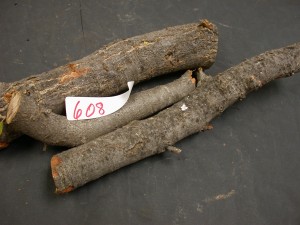It’s the end of the week again. A review of the events and happening in the lab with my staff brought some some concerns. One that turned to a request is ” Please write a blogpost on oak wilt submission”. Apparently, we have been getting quite a number of samples for oak wilt but some of them have not been “good” samples or arrived in proper packaging to give us the best chance for recovery of a potential pathogen. So the following is a short primer on oak wilt sampling and submission to the Texas Plant Disease Diagnostic Lab.
1. Taking sample
What would make a good sample? On our D1178 form (page 2) – Collect branches 1 1/2 inches to 2 inches in diameter that are showing symptomatic leaves. When possible, enclose twigs with symptomatic leaves still attached in a separate plastic bag.

Appropriate branch sample for oak wilt detection. Please identify type of oak if not foliage was submitted with sample.
Here are the reason why this suggestion: Assuming that it is oak wilt (cause by the fungus Ceratocystis fagacearum), a likely place for the fungus to be at is a dying branch. You are not likely to find the fungus is a dead branch. Why a ~2 inch diameter branch and why not the tips and leaves? This fungus is in the vascular system. At the branch tips or leaves, the plant parts are “thinner” and more susceptible to the environmental temperature whereas where it is thicker, the vascular bundles are better insulated and may preserve the pathogen better. So why not larger than 2 inches or even 4 inch branch? For practical reasons, it is much more time consuming and difficult to process a really thick sample.
2. Sending the sample
More from page 2 of form D1178 – Place the plastic bags in a Styrofoam ice chest with frozen ice packs—DO NOT SEND ON DRY ICE. Ship samples by overnight delivery to help ensure accurate diagnosis.
The basic idea here is to keep the sample cool, or in other word – do not let the sample get too warm. Overnight delivery ensure that the sample spends minimal time in transit, further ensuring that it was not sitting in the back of a hot truck in the middle of summer. When it is hot, the fungus will die. If it dies, it will not grow. So in a confirmatory lab, the report will state “NO PATHOGEN FOUND” . Please note that this means what is say. It does not say that there is NO OAK WILT instead it is saying “we did not get anything from the sample that was submitted”. The” NOT on dry ice” bit is that the fungus can also freeze to death. So cool, NOT hot or freezing cold.
A while back, I had a student worker put together a short video on packaging and mailing the sample for oak wilt analysis to the TPDDL. Check out that video here (https://plantclinic.tamu.edu/videos/).
If you like to get more information about oak wilt – check out the Texas oak wilt website (http://Texasoakwilt.org). If there are question about submitting a sample for oak wilt, you can alway contact us at plant clinic@ag.tamu.edu or at 979-8458032.


